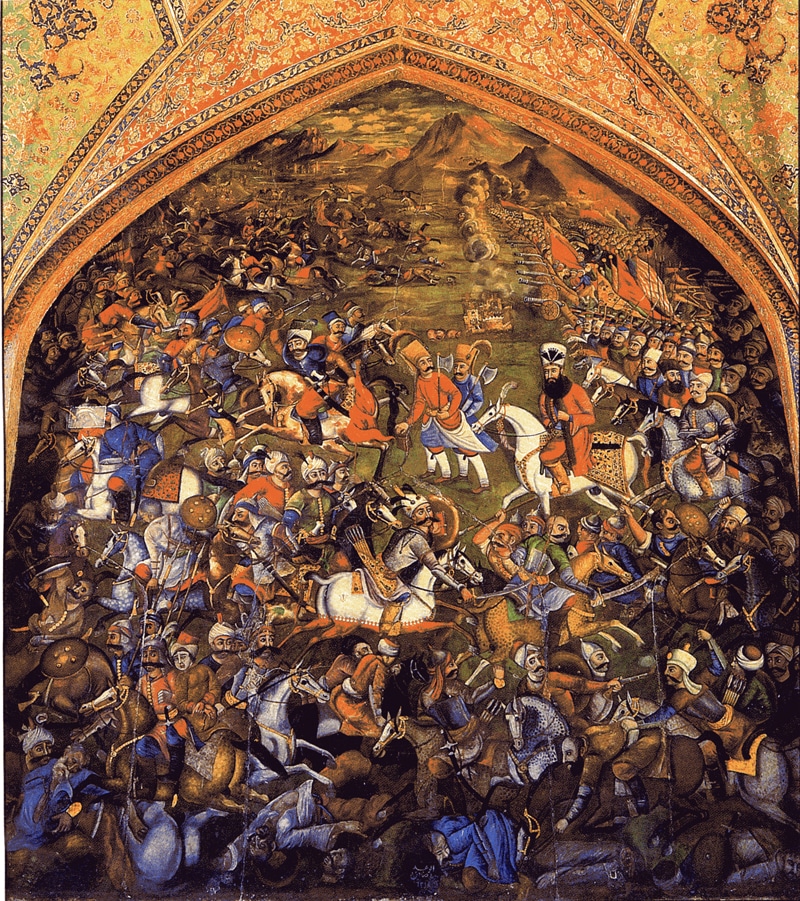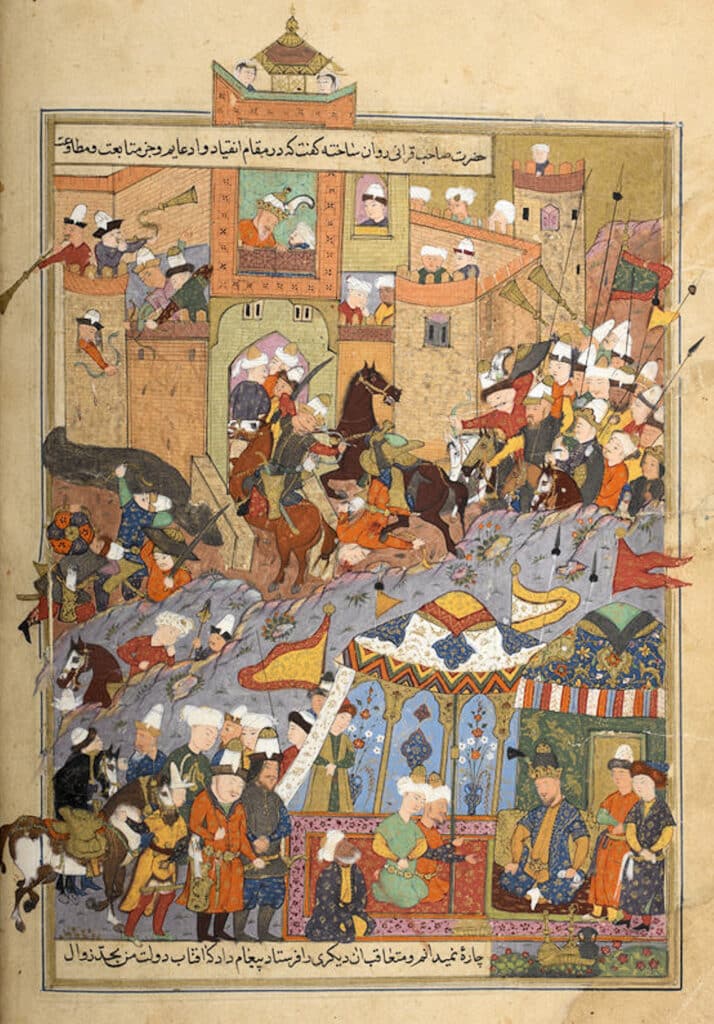This Week in History recalls memorable and decisive events and personalities of the past.
22nd January 1517 – The Ottoman Empire under Selim I defeats the Mamluk Sultanate and captures present-day Egypt at the Battle of Ridaniya

Selim I at the Battle of Chaldiran, depicted at the Chehel Sotoun Pavilion in Isfahan [Xiquinho Silva from Cacau – 32272-Isfahan-Chehel-Sotoon-Museum, CC BY-SA 2.0, https://commons.wikimedia.org/w/index.php?curid=10943593]
Today the Ottoman Empire is generally thought of as the predominant Middle Eastern power from the end of the Medieval Period to the First World War. But what is often forgotten is that until the early 1500s, the Ottomans vied with another great power for dominance of the Islamic world. That power was the Mamluk Sultanate.
The Mamluk Sultanate was a type of state which was once common in the Middle East but in the modern era no longer exists; based primarily in Egypt, it would rule Egypt for three centuries. Mamluks were originally slave soldiers who served the Ayyubid sultanate between 1171 and 1260.

The Battle of Wadi al-Khazandar of 1299, in a 14th-century illustration from a manuscript of the History of the Tatars, depicting Mongol archers and Mamluk cavalry
These were men captured usually in the Caucuses mountains or in Central Asia. Most of them were ethnically Circassian or Kipchak Turkish. However, the slaves could originate anywhere and sometimes were Christians from Ukraine or from other parts of Europe. The Ottomans had a similar institution, known as the Janissaries. These men, however, were mostly enslaved in the Balkans.
Slave soldiers were used by many Islamic kingdoms, because by virtue of their slave status and foreign origin they did not belong to any of the clans or tribes which made up the Islamic kingdoms, and so would not cause intertribal feuding. Moreover, many rulers believed they would not be threatened by their slaves as a slave who took power would have no legitimacy.
Both the Mamluks and the Ottoman Janissaries would, however, become very powerful institutions which threatened the ruling class. While the Ottoman sultans would eventually triumph over the Janissaries in 1826.

A Janissary musketeer. The entire Janissary corps was disbanded during what came to be known as the Auspicious Incident
The Mamluks would come to overthrow the Ayyubid sultans of Egypt and replace them with a Mamluk sultan in 1250.
Even once in power the Mamluks maintained their slave-based system. New Mamluks who showed strength, intelligence or skill would be purchased from slave markets, inducted into the Mamluk army and then freed from slavery. If successful they could rise from the lower ranks of the army into the ruling class of the Sultanate. Local Egyptians were for the most part excluded from the ruling class.
The Mamluks were in many ways a bizarre fusion of a slave army and a knightly order, forming the backbone of the Egyptian army. Their most impressive military victory was that over the Mongol armies at the battle of Ain Jalut in 1260, where the advancing Mongol armies were stopped in their tracks and prevented from invading Egypt. This was one of the first major defeats of the Mongol Empire since its rise several decades before.
The Mamluks would become the scourge of the Crusader states, who at this period held the coastal areas of the Levant. After many years of fighting, the Mamluks would eventually drive the Crusaders out of the Middle East entirely.
The Mamluks would clash with and survive the invasion of the central Asian warlord, Timur, in the late 1300s.

Timur commanding the Siege of Balkh
After Timur’s death, the Mamluks formed the most powerful Middle Eastern state for a time.
The growing strength of the Ottomans would come to threaten the Mamluks. Both empires competed for control of the spice trade between Europe and India, and both empires vied for the position as head of the Islamic world. In this the Mamluks had the advantage as they controlled both the holy Islamic cities of Mecca and Medina, as well as the Abbasid Caliph, who was kept in Cairo.
The first clash between Ottomans and Mamluks was in 1485. The Mamluks had supported a pretender to the Ottoman throne and the Ottomans would raid into Mamluk territory. After six years of fighting, the war ended with the status quo.
In 1514 the Ottomans defeated the newly risen Safavid Persian empire, which the Mamluks had supported. Fearing another alliance between Persia and the Mamluks, the Ottomans quickly turned their attention to the Mamluks, who they would now focus all their might against.

News pamphlet relating the Ottoman–Mamluk War (1516–1517), including an account of Sultan Selim’s visit to Jerusalem. Printed in Basel, dated 1518
In 1516 the Ottomans attacked the Mamluks, and after a string of victories, decisively defeated them at the Battle of Ridaniya on 22 January 1517.
This collapsed the Mamluk Sultanate and left the Ottomans in control of their territory.

Execution of Sultan Tuman bay II in April 1517 (etching by Jan Luyken)
While the Mamluks would never threaten the Ottoman Empire again, the Ottomans made sure to incorporate Mamluk nobles into their new administration of Egypt for centuries to come, and the Mamluks would be an important part of Ottoman Egypt.

Charge of the Mamluks during the Battle of Austerlitz in 1805 (one of Napoleon’s most significant victories, against Russian and Austrian forces), by Felician Myrbach. The French had become familiar with the elite body of cavalry during their campaign in Egypt in 1798
If you like what you have just read, support the Daily Friend

